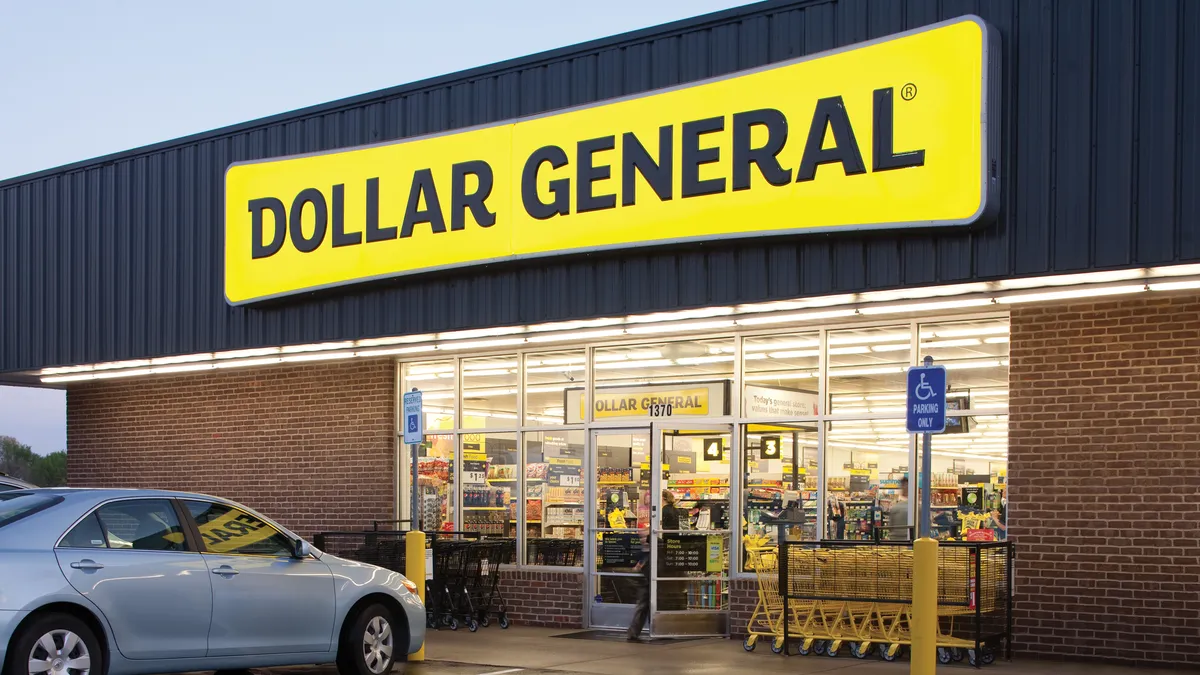Dive Brief:
-
Dollar General on Thursday announced that first quarter net sales rose 6.5% to $5.61 billion, up from $5.27 billion in the prior-year period, (beating the FactSet analyst estimate cited by MarketWatch for $5.28 billion), buoyed by sales from new stores that were partially offset by sales from closed stores, according to a company press release.
-
Same-store sales in the quarter rose 0.7%, with an increase in average transactions partially offset by a decline in traffic. Positive results in the consumables and apparel were partially offset by negative results in the home and seasonal categories, the company said.
-
Dollar General also said that in April the Federal Trade Commission approved its purchase of 322 store locations in 36 states from a small-box multi-price point retailer, with that transaction expected to close in June, those stores will be converted to the Dollar General banner by the end of November. The acquisition will boost previously planned growth of 1,000 new stores this year by some amount and net sales for this fiscal year by some 100 basis points.
Dive Insight:
Dollar General CEO Todd Vasos in his statement Thursday noted the ongoing challenges in retail, but said the company in the first quarter had moved on from the particular hits from income tax refunds delays and the late Easter holiday.
"For the first quarter of 2017, I am pleased with our earnings results which reflect solid management of the business in a difficult retail environment as we overcame our most challenging comparisons from the prior year,” he said. “We continue to execute on our focused strategy and implement our operating initiatives which we believe will improve customer traffic and transactions.”
The retailer, given its position as a discount player with especially thin margins and stiff competition, is indeed doing relatively well, says GlobalData Retail Managing Director Neil Saunders, but he also noted softness in the numbers. “[I]t is clear that Dollar General in particular, and dollar stores in general, are suffering from a slight loss of momentum,” he said in a note emailed to Retail Dive. “This does not mean the format is falling out of favor or that there isn't scope for future expansion, but it does mean that growth is now harder to attain.”
Part of the problem is that dollar stores’ customers are mostly low-income consumers with little wiggle room in their budgets, he said. “While this may only mean they cut out a single non-essential trip to the dollar store or buy one less item when they do visit, in a volume business these small movements have a dramatic impact on growth,” Saunders said.
That means that Dollar General and its rivals must try to appeal to more shoppers with healthier incomes. “Dollar General is still growing its share among these groups, but the rate of advancement is slowing down,” Saunders warned. “Some of this is due to maturity, but some is also down to increased customer sharing, especially among lower-middle income shoppers.”
And that share is going to Wal-Mart, which has made concerted efforts to improve stores and services in recent months, according to GlobalData Retail’s research, and the impending competition from the arrival of Lidl and the expansion of Aldi — two German no-frills grocery chains that have sparked price wars in Europe — are likely to exacerbate that. “[W]e believe that effect is relatively small, but our customer data show Walmart is starting to pull back some custom it had previously lost to dollar stores,” he noted. “The forward concern is that as the market becomes far more price focused, especially as deep grocery discounters like Aldi and Lidl expand, Dollar General could see further and faster erosion of its share of wallet.”
That makes Dollar General’s expansion plans especially important, in order to combat the company’s muted same-store sales. “As much as it runs counter to prevailing wisdom to open new stores, we believe there is sufficient headroom for growth as the small trade area for Dollar General means there are still many locations where it can profitably expand,” Saunders said. “Looking ahead, the cost of new openings, the cost of refurbishing some existing stores, and the cost of investing in some digital initiatives like couponing and customer engagement will likely compress profit. This may be exacerbated by a need to invest more in low prices if circumstances warrant it. While we maintain that Dollar General will remain profitable, we anticipate that the combination of higher costs and smaller productivity gains will bite on the bottom line.”
For its 52-week fiscal 2017 year, the company maintained prior guidance of $4.25 to $4.50 per diluted share and boosted expectation for net sales to an increase of approximately 5% to 7% percent from its prior guidance range of between 4% and 6%. The company's same-store sales growth to follow its prior guidance of slightly positive to an increase of 2%.
Shares rose 4.9% in early trading Thursday.















